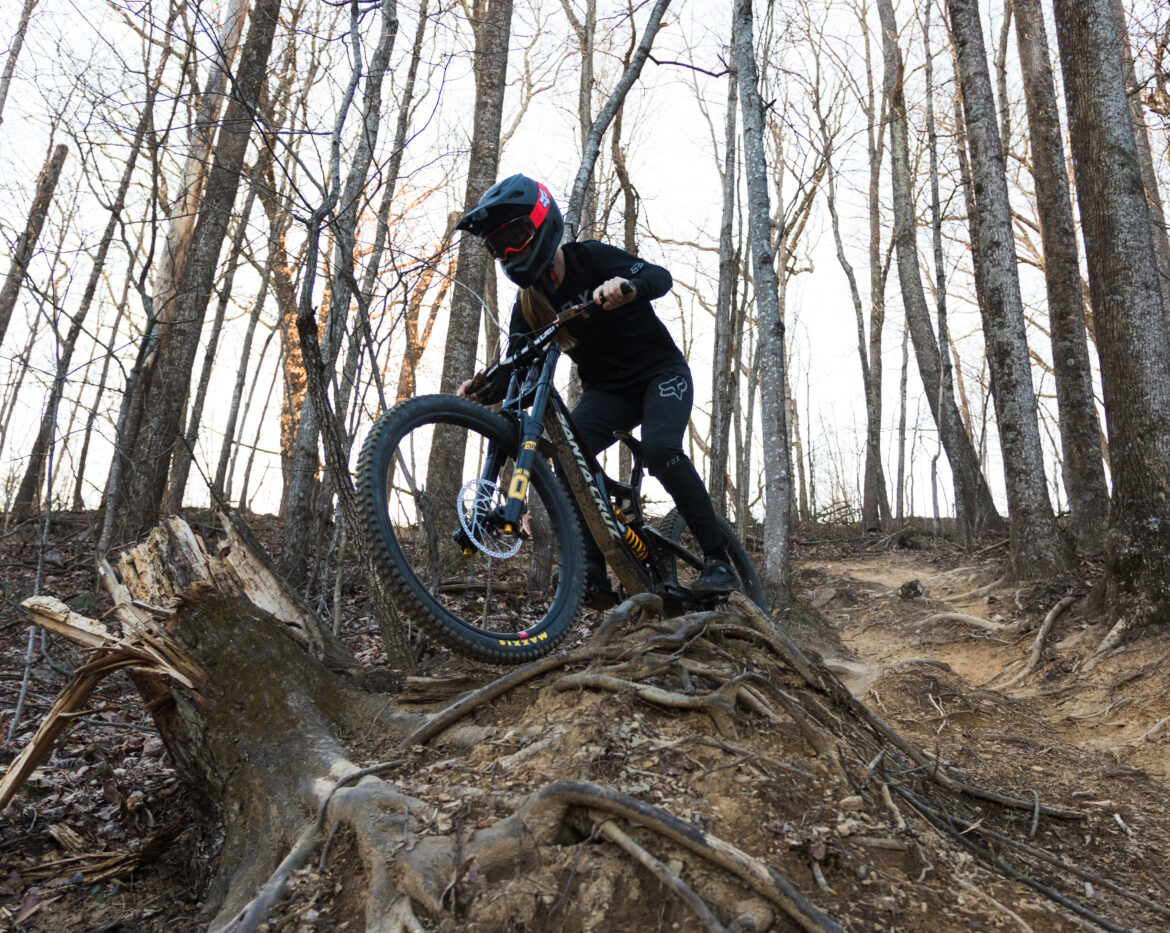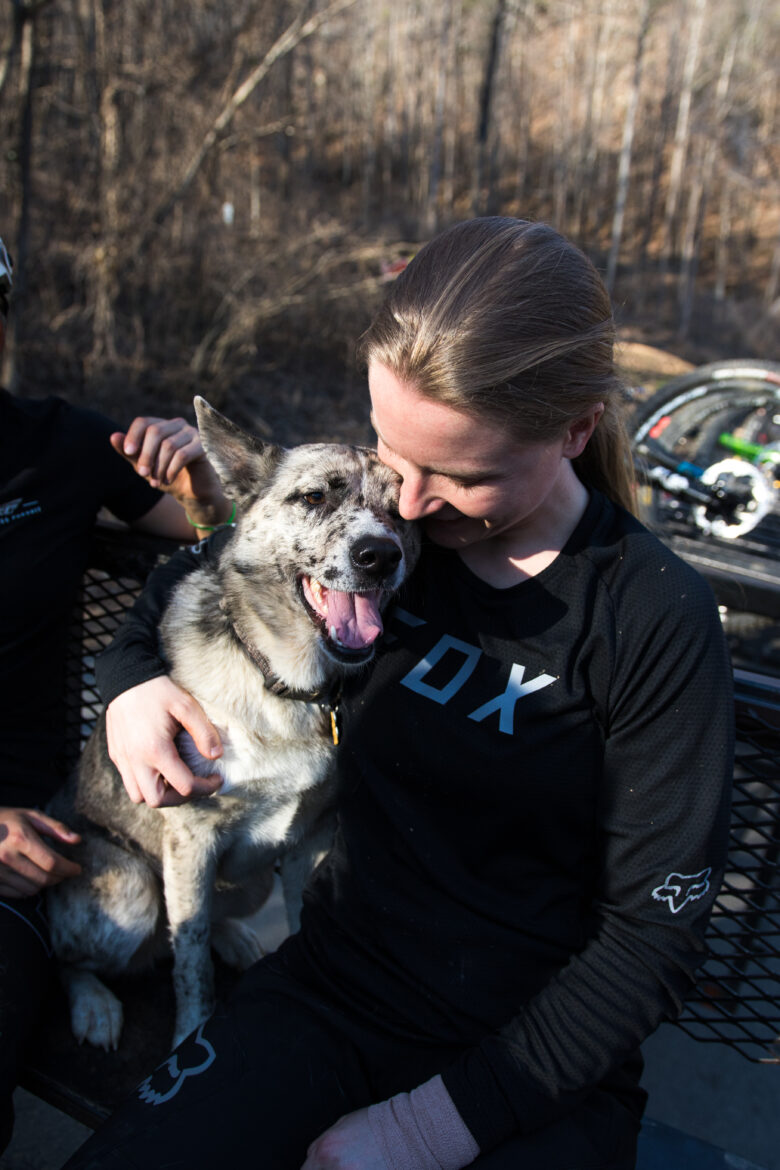
It’s a rare day that someone enters the elite ranks of World Cup Downhill racing from the spandexy XC side of the sport, and that’s exactly the shift Norwegian racer Frida Rønning made back in 2014. Many downhillers light the fire in BMX, or on a dual-crown mountain bike like the one they currently race, but Rønning was flying between the tapes on leg and lung power long before gravity took charge.
Back home in Norway, Rønning aced her way through school and became excited by fast dirt riding at a young age. Sensing some difficulties with balancing university and racing back home, she decided to move to the US and attend Indiana’s Marion University on a cycling scholarship. Rønning raced collegiate XC events until she was distracted by the allure of downhill bikes, and she hasn’t looked back since her final mass-start event in 2015.
Growing up skiing, downhill mountain bike racing made a lot of sense for Rønning. “I love downhill skiing,” she said. “The speed, the adrenalin, and you get to look at the course and figure it out and execute it the best you can. And with downhill mountain biking, we have a bit more practice than I was used to with skiing. I really like that. You have some time to figure everything out, then you get one run to go as fast as you can.”
Getting the most out of the right bike

The 2021 season was Rønning’s first full World Cup calendar, and she was on the Commencal Supreme with RockShox suspension. She joined the Union racing team for 2022, where she will switch over to the Santa Cruz V10 and Öhlins suspension, in addition to full team support that includes a pair of mechanics. With a few rides on the V10 and none on Öhlins suspension, Rønning is super excited to experience the new gear. She says that in prior years, with no pit support, she would have to sprint to the hotel room to change tires if it started raining, which is one of the most immediate ways the team can help her earn results in the lower digits.
Last season Rønning was on a Commencal Supreme, and she says the bike tracked the ground well, providing ample grip, and was great for going fast in a straight line. She’s looking forward to the lighter-weight platform of the V10 which should allow for some different style on track. In terms of wheel sizes, Rønning says “I rode the mullet for a while and it was good. For me, it was a big difference, just being able to use my legs quite a bit more. Also I couldn’t put the saddle as low [with 29″ wheels] because it would hit the tire. So, I’m sure for shorter people mullets are better.”
We asked if there was ever a point where she felt the balanced 29er would have been faster, and Rønning replied, “Not really. It’s a little bit more stable, but not a whole bunch. I could see it being better if you’re really tall or a different kind of rider. For me, the mullet is definitely the way to go.”

In addition to wheel size, Rønning likes to find a dialed balance between her spring rate and compression. For racing, in particular, she finds herself “realizing that some settings may not feel so good, and then you go fast and it feels way better. So don’t just set up the bike how it feels good when you’re just ‘cruisin.'”
Rønning is currently working around a nagging shoulder injury, so setting up the suspension and handlebar height so that her bike can take on more of the work is helpful. She also plays with moving the stanchions around to better suit certain tracks, making the head tube angle slightly steeper or slacker with a slight slide through the crowns.
Rønning’s final bike setup statement was around tires, and she prefers a little higher pressure than some other gravity athletes. She runs a set of Maxxis DHR II tires with DH casings unless it’s muddy. Then she reaches for a pair of Shortys. At 60kg (132lb) Rønning pumps the front tire to 23-24psi and the rear to roughly 27psi.
Doctorate degrees and dirt bikes
Now on to a different sort of pressure. For most riders, a full training and race schedule is enough, but not for Rønning. She’s also working on a Ph.D. in mechanical engineering, researching electrolyzers, or “making hydrogen out of water” as she put it. The fundamental aim of her Ph.D. work is to create ways to save electricity as hydrogen so it can be reconverted and used later, similar to a massive battery. She says that the saved energy and conversion process is fairly efficient, creating a notably clean means of saving and using energy that can be put into the power grid. While a majority of her research can be conducted via computer it is a full-time job and affects her schedule and ability to properly rest. Let’s hope mountain biking provides a meditative zone for her to rest the mind and pin the throttle.
Speaking of throttles, Rønning has also been riding a good amount of moto this offseason, and she’s noticed a few benefits to the bone-vibrating sensation of a two-stroke with two wheels. Most riders mention how the moto helps them gain comfort with speed, and for her, that’s no different, but she says there’s an added advantage of grip and forearm strength that comes with the moto. She can take days off the bike and still get a solid upper body workout without sweating in the gym as much. Rønning lives near Windrock Bike Park in Tennessee and though she can ride the park year-round she still experiences arm pump when she arrives at the rougher European tracks. Moto jarring should help to reduce that fatigue.
Shortly after recovering from a multi-week battle with COVID, with zero training in between, Rønning earned a respectable fifteenth place at this year’s World Champs race in Val di Sole. She also sprinted into a 7th place finish at Crankworx Innsbruck and had some solid results in World Cup events for 2021, and we wanted to know what factors Rønning hopes to improve as she works toward the podium.

She said that her strengths are on the top splits of World Cup tracks, and on shorter runs, which would suggest that fitness is the main element she can improve to put together a full run with similar speeds to what she can currently achieve closer to the start hut. We look forward to watching her through the season to see how the extra preparation pays off.










1 Comments
Mar 18, 2022